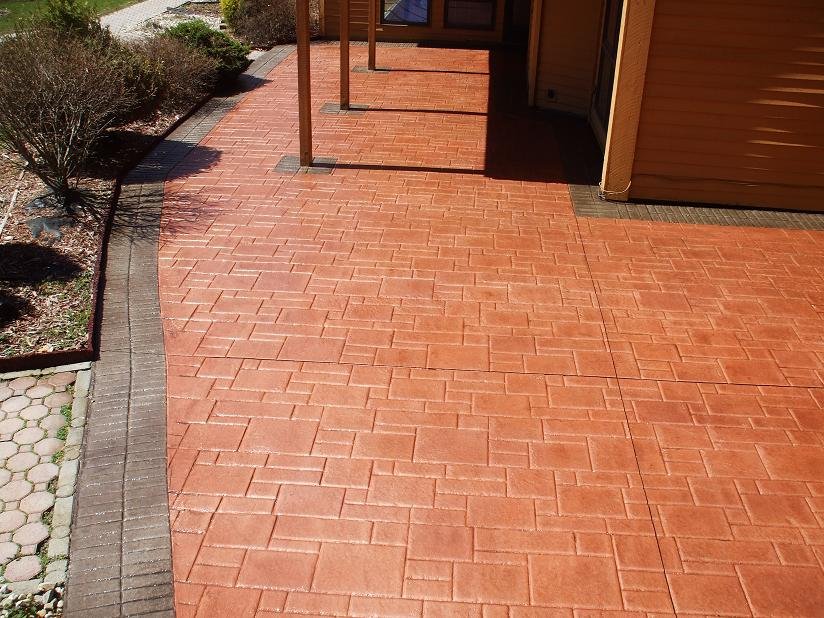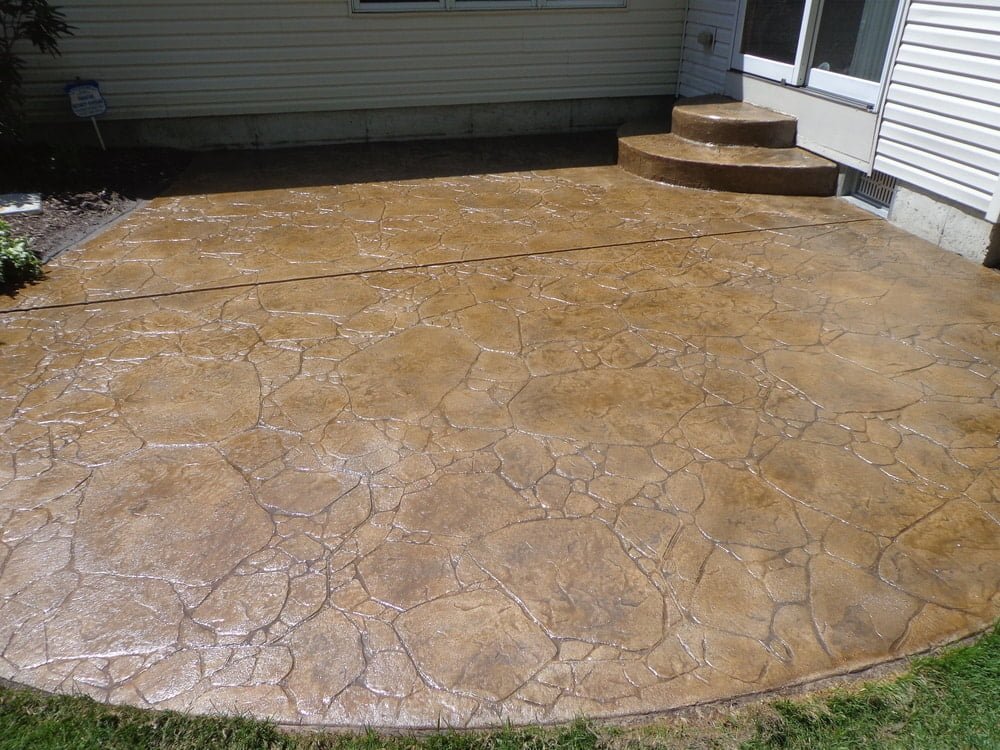Are you enjoying a great stamped concrete patio or driveway? You’ll surely want to keep it in tip-top shape for years to come!
One of the advantages of stamped concrete is a long lifetime. But to do that and preserve its great looks, you do need to take care of it. Fortunately, that care isn’t difficult. With some basic steps, you can keep your surface beautiful and preserve its integrity for decades to come.
Regular Cleaning of Stamped Concrete
Caring for stamped concrete on a regular basis is simple and helps preserve its good looks. You don’t have to worry too much about it. Since it’s concrete and there’s sealant on it, it will hold up well.
Sweeping your walkway, patio or driveway is the most basic level of care. A regular kitchen broom or push broom works just fine. This will keep off the leaves and trash. But at a finer level, it’s also removing dirt and dust that you might not even notice. Regular sweeping will help prevent the buildup of these so that the finish of your stamped concrete can continue to shine through.

If you find that dirt and grime still build up, a pressure washer can do the trick. The high-pressure water is safe for your surface but can help get rid of any dirt that’s too sticky to just sweep away. For extra-tough spots, add a little dish soap to the mix. A mild detergent like that will cut grease without damaging the finish.
Dealing With Tougher Stains
The sealant used on stamped concrete helps make it resistant to stains. However, at times any surface will face other marks or spills. That is especially true on the driveway, where vehicles can leave behind tire marks as well as grease and oil stains.
The first and most important step is to clean up spills or splashes as soon as possible. Wiping them up with a rag may suffice.
As with routine cleaning, a mild detergent with a push broom can help scrub up these problem areas. Pressure washing the area is also helpful.
In particularly tough cases, you may need to use an alkaline degreaser to break up the toughest stains. It’s best to consult with the company that installed your concrete, however. They can recommend a product that is compatible with the sealant that was originally used.
Resealing Your Stamped Concrete
Another important step to preserving your stamped concrete’s beauty and durability is to have it resealed. Fortunately, this only needs to be done every two to three years. If you think the seal may be wearing then, you can pour some water on the concrete. It should bead up. If it’s absorbed into the concrete, then the sealant has worn thin in that spot. In that case, it should be resealed as soon as possible.
The sealant on your concrete will wear out over the course of time. When it wears too thin, water will be able to penetrate the concrete. That can lead to discoloration and cracking.
You can have your contractor reseal your stamped concrete or you can reseal it yourself.
If you decide on doing it yourself, you will want to know what kind of sealant to use. You can get this information from your installer. Using the same sealant helps preserve the quality of the surface. Otherwise, the blend of different sealants could cause a bad reaction that makes the surface cloud or leads to flaking.

Photo by Decorative Concrete Kingdom. Used under CC 2.0 License
Spring or fall, outside the hottest parts of the year, are the best times to reseal your concrete. Follow the instructions on the label. Most sealants work best when applied during temperatures from 55 – 90 F.
Also, try to choose a day when no rain is expected for the next 24 hours.
Be sure to wash and rinse your surface thoroughly. Also, it has to dry completely before applying new sealant. That may take a full day, but you can speed it up using a leaf blower.
You’ll need about five gallons of sealant for every 1000 square feet of surface. Add one jar of anti-skid material and stir it in.
A one-inch nap roller (a paint roller) should be used to apply the sealant. Be careful to roll it on evenly. The coat should be extremely thin; not much is necessary. A thick coat will make the surface look duller.
When the first coat has dried and is no longer sticky, you can apply a second coat if you think it’s necessary. Again, keep it as thin as possible.
Things to Avoid
Your stamped concrete is tough but there are still a couple precautions to take so that it will stay in top shape.
When cleaning, avoid using metal rakes or other objects which could scratch the surface. These can scratch the sealant and even the concrete itself. If you must rake, use a plastic leaf rake.
Make sure to keep the surface cleaned up, though. Don’t allow leaves or trash to stay on it too long since they can trap moisture that leads to mold growth. In the same vein, don’t leave tarps or plastic mats laying on the surface for extended periods.
The same holds true when you have to get rid of snow. A metal blade can do a lot of damage. However, a sturdy plastic blade will work well. If you use a plow, set the blade at least an inch above the level of the ground and remove the rest with your shovel.
Avoid using salt on the ice and snow. It will eat right through the sealant as well as doing other damage. If you live in a climate where you have to deal with ice and snow, you might want to think about a heated driveway – they’re fully compatible with stamped concrete!
Finally, if you have a stamped concrete pool deck, be careful not to store or spill pool chemicals on the surface. In case of a spill, be sure to clean it up. The sealant will stand up to normal concentrations of the chemicals used to treat pools. But high concentrations can break down the surface.
Conclusion
You’ve invested a lot in your stamped concrete, whether it’s for a walkway, patio, driveway, porch, or pool deck. Help that investment pay off by taking care of it. The work involved isn’t difficult. By doing basic cleaning regularly and resealing the surface every couple of years, you’ll be able to enjoy it for years to come!









